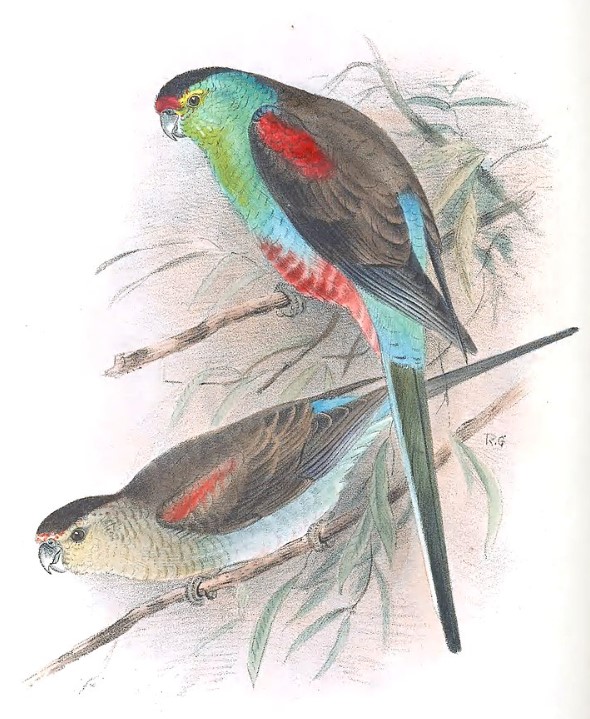The Paradise Parrot (Psephotus pulcherrimus) was discovered on the Darling Downs of Queensland in 1844 by John Gilbert, assistant to eminent ornithologist John Gould. In love with the bird’s colors and grace, he requested its name be given to him. As Gould disliked the use of proper names for new species, it was referred to as pulcherrimus, meaning “very beautiful” Unfortunately, Gilbert died on an expedition led by Ludwig Leichhardt in 1845.

In the course of the expedition, Gilbert met the bird, which he described as ‘my new green parrot of the Darling Downs’, in a number of parts of eastern Queensland, but he wrote only of its beauty and pleasing voice, without mentioning its distinctive nest, which is part of a termite mound. Later, settlers in Queensland and certain adjacent parts of New South Wales became fairly familiar with the Paradise Parrot; they called it various names, including Soldier Parrot because of its upright posture.
In habits and habitat, it is similar to Golden-shouldered and Hooded Parrots, and its flight is swift and undulating. Trappers captured many parrots by taking advantage of the nest site’s easy accessibility. A number of other factors appear to have affected the species, such as grazing sheep and cattle, and recurrent droughts so its numbers had been seriously reduced by the beginning of the century.
As a result of Alec Chisholm’s dissatisfaction with the absence of news regarding the parrot, several Queensland newspapers were enlisted to assist him in the search, both in city areas and country areas, in the years that followed 1917. In 1921, nothing positive was heard about the ‘lost’ parrot until C.H.Jerrard reported having discovered an occupied nest of the ‘lost’ parrot in the Burnett River region, some 300 kilometers north of Brisbane, and reported the discovery to the authorities.
A photograph of both the male and female at their nest in a termite mound was sent to him as evidence to support his claim. The photographs of the living birds have remained the only ones ever taken of the birds to this day. Jerrard continued to see Paradise Parrots there until 1927 when Alec Chisholm joined him in the same area; they stumbled upon a pair of the birds after a very difficult search. To date, Jerrard has seen these parrots only once in the area.

There have been numerous attempts to locate the beautiful bird since that time; however, no substantiated discovery has been made; the last attempt, funded by the World Wildlife Fund in 1980-81, ended in a blank; until now, many searches for the bird have been conducted. The Paradise Parrot is neither confirmed nor found in captivity, and there are fears that it is now extinct as there is no confirmed specimen in captivity at all. It has been suggested that there may still be scattered pairs of bushmen living in the north of the country based on fragmentary reports submitted by Bushmen over the past few years.
There was a public inquiry in Queensland about this bird about 1920, during which a few old settlers reported that it had been known to nest in burrows in termite mounds and on occasions, in cavities excavated in banks of creeks. The Golden-shouldered and Hooded Parrots are also known to nest within termite mounds as part of their nesting strategy.
It is also known as the Beautiful Parrot, Scarlet-shouldered Parrot, Anthill Parrot, and Soldier Parrot. A Paradise Parrot is a medium-sized bird that measures about 270-280 mm in length, including its long tapered tail.
MALE: – The crown is black with a red frontal band, grading to a mid-brown color on the mantle and scapulars; the lower back and upper tail coverts are turquoise. The shoulders of the wing are scarlet; the coverts of the flight feathers and the inner flight feathers are dark brown, grading to a dusky blue color on the outer flight feathers. A turquoise-green face and throat, grading to yellow around the eye, and a turquoise-blue breast and flanks. The belly and crissum are scarlet. In the center of the tail, the feathers are brown-green, dusky at the tip; on the outside, they are greenish blue, tipped broadly with a bluish-white. The eyes are dark brown. A leaden bill with a dark gray cere. There is a brownish-grey color to the feet and claws.
FEMALE: – Like males, except duller; the frontal band, cheeks, throat, and breasts are buff-yellow. There is a small patch of red in the center belly of the lower breast, belly, and crissum. A red shoulder stripe on the flight feathers is reduced; an off-white underwing stripe appears on the flight feathers. IMMATURES: – In young males, the face and breast feathering are emerald-green, and the crown and shoulders are reddish-brown.
The only contact note recorded is a sweet plaintive tit-sweet; a short, sharp musical sound. The nest consists of a tunnel about 20-30 cm long and a chamber roughly 40 cm wide, usually burrowed into a terrestrial termite mound. In the summer and early autumn, the Paradise Parrot breeds.
There are usually five eggs, which are white in color and are about 20-22 x 17-18 mm in size. The female incubates and broods the eggs. This species is found in open woodlands with termitaria from northern central New South Wales (Casino-Moree) to central eastern Queensland (Suttor-Belyando drainage). There are no races. The species may survive in the northern sectors of its range, but it may be extinct elsewhere.


